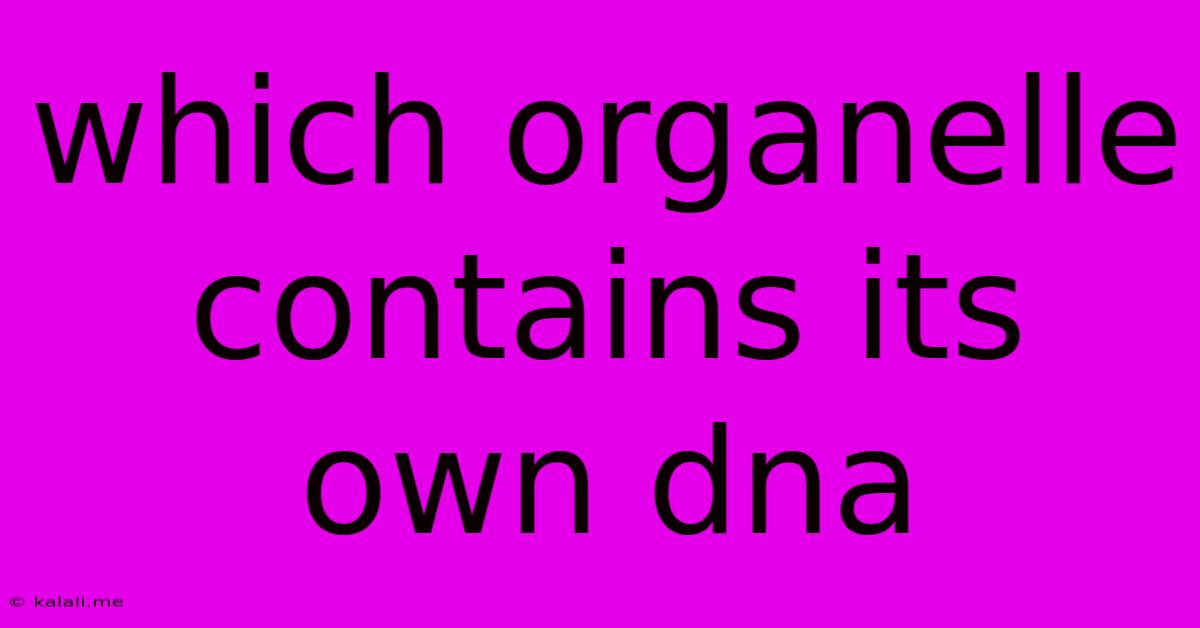Which Organelle Contains Its Own Dna
Kalali
Jun 15, 2025 · 3 min read

Table of Contents
Which Organelle Contains Its Own DNA? Unlocking the Secrets of Mitochondria
The question of which organelle contains its own DNA is a fundamental one in cell biology. The answer, surprisingly, isn't singular. While most people immediately think of the nucleus, there's another crucial player in the cellular energy game that also boasts its own genetic material: the mitochondria. This article delves deeper into this fascinating aspect of cellular biology, exploring the unique characteristics and functions of mitochondrial DNA (mtDNA).
Understanding the Importance of Organelle DNA
Organelles are the specialized compartments within cells that perform specific functions. The nucleus, the cell's control center, houses the majority of a cell's genetic material (nuclear DNA or nDNA), which directs the synthesis of proteins and controls cellular activities. However, the discovery of mtDNA revolutionized our understanding of cellular inheritance and energy production. The presence of independent DNA within organelles like mitochondria highlights the complex evolutionary history of eukaryotic cells.
Mitochondria: The Powerhouses with Their Own Genetic Code
Mitochondria are often referred to as the "powerhouses" of the cell because they are the primary sites of cellular respiration. This process converts nutrients into adenosine triphosphate (ATP), the cell's main energy currency. This vital function requires a dedicated and efficient system, and that's where mtDNA comes into play. Mitochondrial DNA encodes for essential components involved in oxidative phosphorylation, the final stage of cellular respiration.
Key Differences Between mtDNA and nDNA
While both mtDNA and nDNA are crucial for cellular function, there are significant differences:
- Size and Structure: mtDNA is significantly smaller than nDNA, carrying a much more limited number of genes. It's also circular, unlike the linear structure of nDNA.
- Inheritance: mtDNA is almost exclusively inherited maternally. This means you inherit your mitochondrial DNA from your mother.
- Gene Expression: The genes encoded by mtDNA are primarily involved in energy production within the mitochondrion itself, whereas nDNA codes for a far broader range of proteins and cellular functions.
- Repair Mechanisms: mtDNA has a significantly lower repair capacity compared to nDNA, making it more susceptible to mutations. This increased mutation rate is linked to several age-related diseases and disorders.
The Evolutionary Significance of mtDNA
The presence of mtDNA supports the endosymbiotic theory, which proposes that mitochondria were once free-living bacteria that were engulfed by a host cell billions of years ago. This symbiotic relationship proved beneficial for both the host and the engulfed bacterium, leading to the evolution of eukaryotic cells. The retention of mitochondrial DNA provides strong evidence for this evolutionary theory.
Implications of mtDNA Research
Research on mitochondrial DNA has significant implications across various fields:
- Medicine: mtDNA mutations are associated with a range of diseases, including mitochondrial myopathies, Leber's hereditary optic neuropathy, and some forms of deafness. Understanding mtDNA is crucial for developing diagnostic tools and potential therapies for these conditions.
- Forensics: mtDNA is used in forensic science due to its maternal inheritance pattern. It can be helpful in identifying individuals and tracing ancestry.
- Evolutionary Biology: Studying mtDNA variation across species helps scientists understand evolutionary relationships and population dynamics.
In conclusion, while the nucleus houses the vast majority of a cell's genetic information, the mitochondrion stands out as the only other organelle with its own distinct DNA. Understanding the structure, function, and evolutionary significance of mtDNA is essential for advancing knowledge in various scientific disciplines. Further research into mtDNA holds immense potential for unraveling the mysteries of cellular biology and developing new medical and forensic applications.
Latest Posts
Latest Posts
-
Which Of The Following Equations Is Correct
Jun 15, 2025
-
A Group Of Similar Cells Performing A Specific Function
Jun 15, 2025
-
Find The Approximate Area Of The Shaded Region
Jun 15, 2025
-
Tissue That Forms Inner Lining Of Mouth
Jun 15, 2025
-
Dot Product Of Two Unit Vectors
Jun 15, 2025
Related Post
Thank you for visiting our website which covers about Which Organelle Contains Its Own Dna . We hope the information provided has been useful to you. Feel free to contact us if you have any questions or need further assistance. See you next time and don't miss to bookmark.